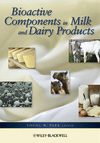Tharp & Young


A: Inclusions add considerably to ice cream's sensory appeal. However, the use of both particulate and/or syrup inclusions must be properly managed to avoid serious negative effects on quality to both ice cream and inclusions.
Beyond the obvious negatives of using poor-quality inclusions, there are indirect effects on ice cream texture that can be equally degrading. Inclusions that are added "warm" will melt ice in the immediate vicinity of the inclusion. During hardening, water will deposit on existing ice crystals, increasing their size and increasing the likelihood of coarse texture. Pre-chilling inclusions and lowering ice cream draw temperatures minimize this effect.
Injected syrups can be too thick or stiff, or too thin or stringy. It is important to balance desired eating quality and avoid "puddling," which results when syrup migrates to the bottom of the carton. Syrups should be thick enough to minimize their flow properties in the ice cream but not so thick as to cause other difficulties. High-viscosity syrups may or may not be responsive to shear thinning that occurs during injection. Such properties can be engineered into syrup formulations. Low ice cream and syrup temperatures can also be helpful. It is important to harden the ice cream rapidly so that the ice cream freezes quickly, holding the syrup within the structure of the ice cream.
Negative effects of inclusions on ice cream texture can be minimized by encouraging the development of small ice crystals in fresh ice cream. These practices include increasing water immobilization in the mix, freezing to the lowest feasible exit temperature, rapid hardening and minimizing exposure to heat shock.
Particulate inclusions can have associated dust, which often contributes to sandiness by acting as sites for lactose crystallization. To minimize this, general tendencies for particulate inclusions to dust need to be known and particulate handling should be managed to discourage dust development. Furthermore, particulates (or even syrups) that absorb water readily can remove water from ice cream and make the ice cream more vulnerable to sandiness by concentrating lactose in the vicinity of the inclusion. To minimize the general influence of particulates on sandiness it is important to avoid high lactose levels in the mix used for such products.
Finally, when adding inclusions, keep in mind that ice cream is displaced and the weight of the finished product increases. This typically calls for an adjustment of ice cream overrun to maintain finished product weight. This, in turn, increases the ice cream's vulnerability to many of the effects already noted.
Q: How does ice cream affect inclusion quality?
A: Inclusions (both fluid and particulate) typically have lower moistures and lower water activities (Aw) than the ice cream to which they are added. This makes unfrozen water flow from ice cream to inclusion. Added moisture can make inclusions (depending on type) soft, mealy and/or thin with less bite, chew and/or crispness. Direct and indirect modification of flavor delivery is also possible. Loss of visual appeal such as loss of inclusion integrity or loss of clear differentiation between the added inclusion and ice cream may result.
Adding inclusions under conditions where limited amounts of unfrozen water are available preserves both ice cream and inclusion quality. Conditions include temperatures under which the inclusion is added, the temperature of the ice cream to which inclusions are added, physical abuse of the inclusion at time of addition, speed and temperatures of hardening, and thermal abuse of the finished food.
Particulate inclusions can be protected by modifying compositions (managing Aw) and forms (size and shape) or applying a variety of surface treatments. Managing composition and/or form can deter moisture migration. Water-free coatings such as fats, oils, chocolate, etc., offer effective barriers to water transfer, but may change the eating quality of the specific inclusion. Hard candy coatings can also be used. These coatings typically have even lower water activities than the inclusion it is protecting. Thus, candied inclusions tend to absorb moisture quickly and lose their desired eating quality more rapidly.
Injected fluid inclusions vary significantly in composition, color, density, viscosity and rheological properties. The amount, formulation and pattern of injected syrups can depend on the specific design of the injection device being used. Injector design varies greatly and can affect the conditions under which syrup is delivered into the ice cream. This, in turn, affects how water flows to the syrup from the ice cream and affects structural integrity and stability of the syrup as well as that of the ice cream and ice cream/syrup interface.
Looking for a reprint of this article?
From high-res PDFs to custom plaques, order your copy today!









